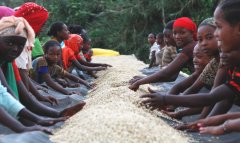Auction is the main means of coffee trading in Kenya | introduction to the historical development story of Kenyan coffee beans by NCE
Auctions may be one of the most complex and inefficient ways to complete a coffee transaction. But he was one of the first methods used in the coffee trade. Today, it is still the main method of buying coffee from countries such as Kenya and Tanzania and plays an important role in promoting high-quality microbatches. At best, it can also be used as a way to find good bakers and producers, a way to build closer relationships through the supply chain.

Coffee from Ile R é union on the island of Reunion was introduced by the British in 1893, and it was not until the 1930s that the locals were able to grow coffee on their own land. Before 1934, most coffee plantations were forced labor plantations, where blacks were slaves.
Progress was made in the 1930s when the Kenyan Coffee Commission was established and the first auction was held in 1935. In 1944, cooperatives were institutionalized, requiring the participation of small farmers (5 acres or less), weakening their industrial status because the members of the coffee committee board were mostly landowners. Kenya became independent in 1963, land was redistributed, and cooperatives began to be able to lend. A number of new processing plants have been built and are still in use today as an important part of the local coffee supply chain. Today, about 75% of Kenya's coffee fields are cultivated by small farmers, but they account for only about half of their annual output of 50,000 tons.
The Government of Kenya recognized the importance of the country's agricultural sector and made exports a priority for economic growth. In the same year of independence, the coffee exchange the Nairobi Coffee Exchange (NCE) was established, and Kenya mandated weekly coffee auctions.
Composition of the Exchange Commission

The Exchange Committee shall consist of-
A) the nominations of the representatives of the five growers trading through the exchange are as follows
(I) A person nominated by cooperatives in the eastern, north-eastern and coastal areas:
(ii) A person nominated by cooperatives in the central and Nairobi regions.
(iii) A person nominated by cooperatives in the Rift Valley, the West and the Nyanza region.
(iv) one person nominated by the owner of a small and medium-sized coffee garden; and
(v) a person nominated by the property owner.
B) two dealer representatives, one nominated by a small and medium-sized dealer and the other nominated by a large dealer
C) A person representing commercial millers, marketing agents and warehouse managers
D) one representative of the Kenya Coffee Committee
E) Executive Officer of the Exchange Commission
Important Notice :
前街咖啡 FrontStreet Coffee has moved to new addredd:
FrontStreet Coffee Address: 315,Donghua East Road,GuangZhou
Tel:020 38364473
- Prev

Impact of Ethiopian Commodity Trading Exchange ECX on Coffee Export quality | Coffee bean value chain
The coffee atmosphere in Ethiopia is very strong. His unique geographical environment and climatic conditions make the coffee taste wonderful. Rich, the depth, width and breadth of the flavor are among the best. As the oldest coffee drinker, how did Ethiopia grow into a huge coffee empire? This is closely related to the Ethiopian Commodity Exchange, Ethiopia in 2008.
- Next

Flavor and taste characteristics of Kenyan coffee beans | introduction to SL28 history and flavor brewing methods of coffee varieties
Sour, clean and beautiful, I believe most coffee lovers will think so when they drink Kenyan coffee. High quality acidity is the backbone and soul of Kenyan coffee. Kenyan coffee is sour and full, covering 29 flavors, including plum, blackcurrant, citrus, lime and grapefruit. One of the most famous is when
Related
- Detailed explanation of Jadeite planting Land in Panamanian Jadeite Manor introduction to the grading system of Jadeite competitive bidding, Red bid, Green bid and Rose Summer
- Story of Coffee planting in Brenka region of Costa Rica Stonehenge Manor anaerobic heavy honey treatment of flavor mouth
- What's on the barrel of Blue Mountain Coffee beans?
- Can American coffee also pull flowers? How to use hot American style to pull out a good-looking pattern?
- Can you make a cold extract with coffee beans? What is the right proportion for cold-extracted coffee formula?
- Indonesian PWN Gold Mandrine Coffee Origin Features Flavor How to Chong? Mandolin coffee is American.
- A brief introduction to the flavor characteristics of Brazilian yellow bourbon coffee beans
- What is the effect of different water quality on the flavor of cold-extracted coffee? What kind of water is best for brewing coffee?
- Why do you think of Rose Summer whenever you mention Panamanian coffee?
- Introduction to the characteristics of authentic blue mountain coffee bean producing areas? What is the CIB Coffee Authority in Jamaica?

